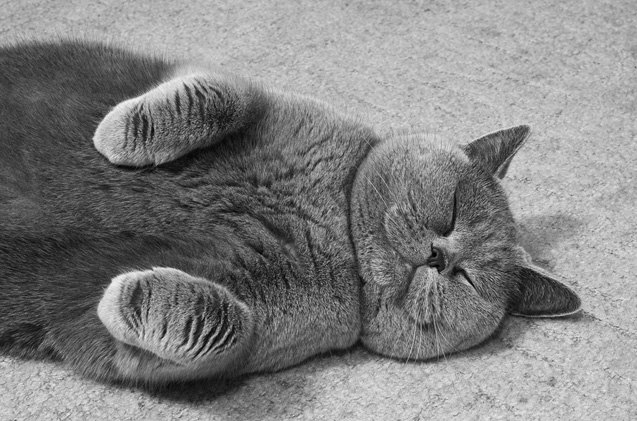5 Cool Cat Facts You Didn’t Know

Amaze and stump your friends with strange cat-nerd trivia facts.
Felines are definitely interesting creatures who always keep us guessing. And each cat has his own unique personality and preferences. But even though you may have shared your home with cats for many years, and even if you have spent many hours as a volunteer in a cat shelter, there are probably still many facts about this species that you were never aware of. Continue reading to learn about some of the most fun facts about felines that will make you love and appreciate them even more than you already do.
1. Purring Starts at One Week of Age, and It’s Really a Mystery
When kittens are a mere one week old, they learn how to purr. And what is really neat about their purring is their ability to continue to purr nonstop while inhaling and exhaling, never missing a beat. While they are young, cats purr in monotone. But once they get older, they can purr in two to three different tones to switch things up.
Cats will typically purr when they are content, but they may also use this as a means to comfort themselves when they are not feeling well or when they are in pain. Therefore, do not always assume that a purring feline is a happy one. Look for other signs in the kitty’s demeanor that would alert you to pain or health issues.
Scientists and feline experts have yet to figure out where the purr actually comes from, though. Some believe it may come from the throat, while others think it may actually start in the cardiovascular system.
Did you know? Cats purr at a healing frequency, too! That’s right: another fascinating fact about purring is that its frequency can be healing. The frequency range is 20-150Hz, so kitties may use purring to heal their bones and soft tissues. This might be another reason why felines purr after they are stressed or when they need to rest and restore their body, not just when they are happy and relaxed.
If you are familiar with the use of healing frequencies that can help humans, this probably immediately makes a lot of sense to you. And this might mean that, if you sit or lie down next to a purring kitty, you might benefit from the frequencies as well. But even if that is not the case, one thing is certain: a content and relaxed cat that’s purring in your lap or right next to you is likely going to help you relax and feel loved too.
2. Cats Really Do Dream
You may have noticed your kitty making strange sounds or twitching his limbs while he sleeps, and you may have wondered if it is possible that he is dreaming. Or, you might have seen your cat wake up suddenly and appear startled, as if waking from a bad dream just like people do sometimes. This, too, might have got you thinking about the possibility that your kitty might be having a variety of dreams, including those that can be scary.
Well, as it turns out, cats are very much like humans in the sense that they, too, can dream. The same brain waves that humans produce when they enter into a deep sleep (i.e., when they are in the REM, or rapid eye movement, stage of sleep) are produced by cats when they are really relaxed and sleeping deeply rather than just taking a short nap.
Note: If you think that your cat is dreaming, even if you believe he’s having a nightmare, there’s probably no need to wake him up, as doing so might just end up startling him.
3. Cats Can Tolerate Hot Temperatures, and They Sweat
The domestic cat’s ancestors were desert-dwelling felines who got very used to being in hot, dry climates. This is why your kitty prefers a warm environment over a cold one. Nevertheless, if your cat gets too overheated, he will begin to pant and show other signs of heat exhaustion and dehydration that are serious and require immediate attention.
Also, cats sweat through their paws. On a really hot day, you might even notice that your kitty leaves behind wet paw prints as he walks. If this is the case, get him to a cool area and provide him with plenty of wet food and fresh, clean water to rehydrate him and cool him off.
4. They Use a Different Voice to Communicate with You
You can learn a lot about your cat by observing his behavior, and knowing the basics about feline body language can help you figure out how he is feeling or what he wants from you. But, in addition to using body language, such as the position of his tail, his overall posture, or even the way his eyes look, your cat also tries to communicate his feelings through various vocalizations.
When they want to communicate with their human guardians, cats will revert back to their “kitten voice,” or the vocal stylings they used when they were babies to get their mother’s attention. On the other hand, when they communicate with fellow felines, their voice is different because they stick with different sounds to talk to other cats.
Felines are also known for using various voices to manipulate their owners into giving them what they want. As a cat owner, you might know when your cat wants to play versus when he is begging for food, simply based upon the sound of his voice. Clever, huh?
5. They Don’t Need to Chew Their Food
Have you ever watched your kitty eating and realized that he doesn’t really chew his food much? Maybe you’ve seen him swallowing pieces of food whole. And this might have made you wonder if that’s normal. Well, it turns out that it is.
Cats have the ability to swallow chunks of food without chewing it, and their bodies will digest the food just fine. This explains why you might find whole pieces of meat or dry food on the floor when your cat throws up. Rest assured that this is normal feline behavior, even though it doesn’t make much sense to humans.
Side note: If you start to notice changes in your cat’s eating habits, such as how much he eats or even the way he bites, chews, and swallows his food, it is a good idea to try examining his mouth. Difficulty biting and chewing his food might be a sign that his teeth and gums aren’t as healthy as they should be or there might be another oral health concern that needs to be addressed. Consulting with a vet you trust can help you get the answers you need.
Use These Facts to Know Your Cat Better
Now that you know some neat facts about cats, you might have an even deeper appreciation for your one-of-a-kind feline companion. And by understanding your pet better, you could take additional steps to ensure he has everything that he needs to be well and to feel loved.

Lisa Selvaggio is a freelance writer and editor, and our resident cats-pert, with certifications in pet nutrition and pet first aid. She enjoys producing content that helps people understand animals better so they can give their pets a safe and happy home.
More by Lisa Selvaggio























